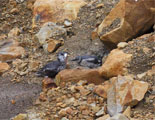 |
 |
 |
 |
|
Photo by N. Hatch/USFWS |
|
 |
|
Adult Kittlitz’s Murrelet delivers a capelin to a chick just prior to fledging from the nest, Icy Bay, Alaska, August 2008. Photo by N. Hatch/USFWS |
|
Endemic to coastal Alaska and eastern Russia, the Kittlitz’s Murrelet (Brachyramphus brevirostris) is one of the rarest seabirds in the world. The majority (roughly 90%) of the global population breeds, molts, and winters in Alaska. During the breeding season, this species often associates with tidewater glaciers, and glaciated fjords and streams. Kittlitz’s Murrelets have low reproductive rates: they are non-colonial, likely delay breeding until three years of age, and lay a single egg, typically in recently deglaciated areas and often at high altitudes on rock scree slopes. The winter range of the Kittlitz’s Murrelet is not well known, but based on opportunistic sightings, is likely pelagic.
The current Alaska population is estimated to be approximately 16,000 birds (nearly half occur in southeast Alaska). This represents a dramatic decline over the past 30 years with declines of up to 18% per year in some core areas. Speculated causes for decline include oil pollution, glacial recession (and cascading effects thereof), gill-net mortality, and reduced availability of preferred forage fish. The fate of the Kittlitz’s Murrelet is likely linked to changes in climate; extirpation in some key populations is predicated as early as 2030.
Conservation Action
Perhaps the greatest impediment to conservation of the Kittlitz’s Murrelet is a lack of information on their biology and factors limiting population growth. Listed by the National Audubon Society as one of the “top ten most endangered birds in the country,” the Kittlitz’s Murrelet is one of the least understood species in North America, with very little known regarding reproductive success, adult survival, and foraging ecology. Thus monitoring efforts should be coupled with directed research efforts to help identify factors limiting population growth of this species.
The U.S. Fish and Wildlife Service has partnered with the National Park Service, Alaska Department of Fish and Game, Wildlife Conservation Society, Dancing Star Foundation, Colorado Division of Wildlife, and several universities to study these factors at one of the most important population centers: Icy Bay, Alaska. Approximately 10-15% of the Alaska population occurs in Icy Bay during the breeding season and this is the only area where Kittlitz’s Murrlets continue to outnumber all other alcids. Partner commitments and funding to continue this important work have been secured through 2012.
Important Findings
To date, this cooperative study represents the single largest field effort dedicated to the conservation of the Kittlitz’s Murrelet. Monitoring efforts, including development of a long-term monitoring plan, have been conducted since 2002. Despite the pristine conditions and that Icy Bay represents the highest density of Kittlitz’s Murrelets in any area, a decline of 53% over six years was documented. In addition to population monitoring, long-term data have been collected on reproduction and survival. New information on previously unknown aspects of the natural history and ecology of this species, including adult and juvenile dispersal, diet, molting patterns, movements, and nesting and foraging behaviors, have also been collected. Additionally, blood, tissue, and feather samples are currently being tested for As part of these ongoing efforts, 135 adult and three juvenile Kittlitz’s Murrelets have been captured, banded, and measured. Ninety-six radio-transmitters have been deployed and tracked during the breeding and post-breeding seasons. Despite high fecundity (90% based on hormone and protein levels), productivity of radio-tagged adults was low (5% attempted to nest; even fewer fledged young successfully). Another surprising result was that adult mortality during the breeding season was relatively high (11%; all resulting from avian predation), suggesting that adult survival may be driving the decline. Data collection, analyses, and reporting are ongoing. Several peer-reviewed publications and annual reports are available.
Benefits of Partnerships
Partner agencies and institutions, and in particular, the National Park Service, have prioritized this collaborative effort to help conserve the Kittlitz’s Murrelet. To date, over $500,000 has been awarded from competitive grants to this effort, including funding for efforts to continue through 2012. The grants have and will support data collection, laboratory analyses, seasonal employee salaries and travel, and one graduate student assistantship. Additionally, all partners provide in-kind contributions and base funding to cover salaries, travel, vessel time, and some field equipment. By collaborating with a diversity of partners, the plight of the Kittlitz’s Murrelet has permeated different audiences throughout the world. Using public and scientific presentations, websites, and magazine and newspaper articles, we are successfully raising both public and agency awareness about this declining species.
For More Information
Michelle L. Kissling
U.S. Fish and Wildlife Service
3000 Vintage Blvd., Suite 201
Juneau, AK 99801
(907) 780-1160
alaska.fws.gov/
PDF FILE: of Michelle Kissling's Research
Kittlitz’s Murrelet Cooperative Study in Icy Bay, Alaska
August, 2008

